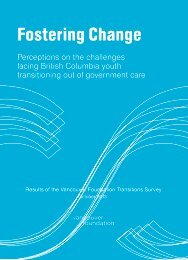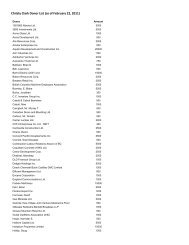from the ground up - The Tyee
from the ground up - The Tyee
from the ground up - The Tyee
Create successful ePaper yourself
Turn your PDF publications into a flip-book with our unique Google optimized e-Paper software.
uilding. So we’re reducing <strong>the</strong>ir steam use by 600,which reduces natural gas burning by 860 at <strong>the</strong> steamplant -- that’s 150 times a year. So <strong>the</strong> net affect ofadding this building is to reduce natural gas burningat UBC.”Robinson hopes building symbiosis models such asthis will not only inspire future construction to rely onexisting systems and improve <strong>the</strong>m, but will inspireo<strong>the</strong>rs to think of sustainability as being about morethan just one building.“Sustainability is not a building scale phenomenon,it’s an actual neighbourhood or community scale,” hesays.Water, water everywhereFew places in <strong>the</strong> country get as much rain as Vancouver,so it seemed unnecessary to <strong>the</strong> Sustainability Initiativethat all <strong>the</strong> water for CIRS had to be pumped in<strong>from</strong> <strong>the</strong> city reservoir when less than five per cent of<strong>the</strong> building’s water had to be drinkable.Instead, CIRS will act as a water treatment plant, collectingand storing rainwater, treating it to grey waterstandards, and using it for <strong>the</strong> building’s non-potablewater needs, like toilets, urinals, and irrigation.“This location we get around 1,200-1,300 millimeteresof rain per year, and we have a catchment areaof around 500-600 square metres, so <strong>the</strong>re’s a lot ofwater we can harvest during <strong>the</strong> year,” says Cayuela.“We have a 100 cubic metre system essentially thatwill be our main repository for rainwater harvesting,and we’re going to treat water on demand.”<strong>The</strong> treatment process will be aerobic: pumping oxygeninto <strong>the</strong> water to encourage bacteria to eat wastematter and turn it into carbon dioxide. It’s a moreenergy intensive process than anaerobic treatment,which doesn’t require oxygen but produces methanegas, making it a potentially more dangerous methodof water treatment.During slower periods of <strong>the</strong> year, such as <strong>the</strong> summerand Christmas break, CIRS will treat sewage water<strong>from</strong> o<strong>the</strong>r buildings, <strong>the</strong>reby reducing <strong>the</strong> amount ofwastewater <strong>the</strong>y produce. Excess water or storm runoff will be treated and redirected into a well drilledinto <strong>the</strong> aquifer, not only improving <strong>the</strong> quality ofwater returned to earth, but preventing <strong>the</strong> erosion ofnearby cliffs.“<strong>The</strong> runoff <strong>from</strong> every building on campus rightnow goes down through <strong>the</strong> soil, hits <strong>the</strong> clay layer,and goes off through <strong>the</strong> cliffs and erodes <strong>the</strong> cliffs,”Robinson told <strong>The</strong> <strong>Tyee</strong>.“Our water discharge will go down <strong>the</strong> well andrecharge <strong>the</strong> aquifer. So it won’t contribute to <strong>the</strong> clifferosion.”Inhabitants vs. occ<strong>up</strong>ants“We think <strong>the</strong> new sustainability agenda is about makingpeoples lives better, not just environments’ lifebetter,” says Robinson.“We define an occ<strong>up</strong>ant as a passive recipient ofbuilding systems: you go in, you can maybe turn onyour lights, you can maybe open your window, andthat’s it. Everything else, you don’t know about, youcan’t control. Can we instead create a building wherepeople are inhabitants, where <strong>the</strong>y have a sense ofplace and engagement with <strong>the</strong>ir actual building andwith <strong>the</strong> spaces where <strong>the</strong>y work.”Robinson aims to do that by having each of <strong>the</strong> building’sinhabitants sign a sustainability charter, committing<strong>the</strong>mselves to achieving CIRS goal of benefitting<strong>the</strong> environment. But Robinson doesn’t expect peopleto work towards a new level of sustainability out of<strong>the</strong> goodness of <strong>the</strong>ir own hearts. Instead, he’s offeringinhabitants five benefits: high air quality, accessto daylight everywhere, individual control of yourworkstation’s atmosphere, real time feedback on how<strong>the</strong> building is doing, and <strong>the</strong> ability to vote on <strong>the</strong>building’s control systems.With <strong>the</strong> exception of <strong>the</strong> 450 seat auditorium -- <strong>the</strong>largest lecture hall on campus and <strong>the</strong> only one lit byskylights -- Robinson and Cayuela like to boast thatevery horizontal surface in CIRS is covered in windows,not only allowing in natural light, but givingpeople control over <strong>the</strong> air quality by using windowsthat open manually.“We’re putting a sensor in each window -- <strong>the</strong> reason70








